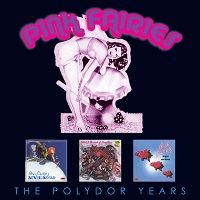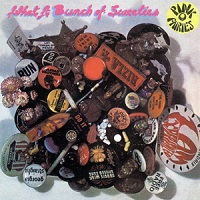By DJ Monk
 The history of rock ‘n’ roll is littered with casualties, including bands who, for one reason or another, were never destined to make it – but some of whom nevertheless have gone to be some of the most influential artists of their time, whose music still resonates and indulges listeners generations later. It could be argued that Pink Fairies are just one such act, whose star burned briefly for the shortest of times before imploding, occasionally resurfacing over the years to remind us of their once inglorious glory years.
The history of rock ‘n’ roll is littered with casualties, including bands who, for one reason or another, were never destined to make it – but some of whom nevertheless have gone to be some of the most influential artists of their time, whose music still resonates and indulges listeners generations later. It could be argued that Pink Fairies are just one such act, whose star burned briefly for the shortest of times before imploding, occasionally resurfacing over the years to remind us of their once inglorious glory years.
Formed when three members of the anarcho-hippie collective The Deviants fired singer Mick Farren in the midst of a disastrous US tour, returned home and re-ignited their relationship with former Pretty Things drummer Twink (on whose ‘Think Pink’ solo album they had collaborated before embarking on said tour). Reflecting the ramshackle nature of the times, they underwent numerous line-up changes and additions, although the core membership of guitarist Paul Rudolph, bassist Duncan Sanderson and Russell Hunter remained intact for the first of the three albums they recorded for Polydor Records (which, as the title suggests, make up this new boxset retrospective).
Pink Fairies’ tentacles extend deep into the early 1970s music scene. They had close ties with Hawkwind (Rudolph left the Fairies after the second album and would eventually go on to replace Lemmy when the latter was fired) and the ultimately ill-fated Shagrat, formed by former Tyrannosaurus Rex percussionist Steve Took, who had used the Pink Fairies name for another collaboration, this time with Twink and the aforementioned Mick Farren, from whom they would recruit Larry Wallis after Randolph’s departure. Wallace, of course, would later go on to team up with Lemmy in the first incarnation of Motörhead, whose version of the Fairies’ ‘City Kids’ was a staple of their early setlists.
But, what of the albums themselves? Have they stood the test of time? Well, the answer, as it ever is with retrospective collections of this nature, is yes and no…
‘Never Never Land’, originally released in 1971, is very much an example of a band trying to find their feet, their own sound and style, and as such is something of a mishmash of sounds. Opener ‘Do It’, for example, as well as later cuts such as the NWOBHM-predictive ‘Teenage Rebel’ and the extended workout of ‘Uncle Harry’s Last Freak Out’ (still regarded as one of the most influential jams of its type) are the sort of slice of proto-punk that, at the time, earned them comparisons with US contemporaries such as MC5 and sowed the seeds for the likes of The Melvins and, more latterly, Thee Oh Sees (in their various incarnations) in their use of double drum rhythms and melodies. Of course, ‘Do It also was covered, to great effect, by Henry Rollins on his 1988 compilation of the same name, showing the cross-generational appeal that the Fairies subsequently were to earn.
‘Heavenly Man’ and the title track, on the other hand, see them revisit those fateful days on the West Coast with their lazy psychedelia, while ‘Say You Love Me’ visits the folk-edged hard rock territory the likes of Thin Lizzy were also starting to explore, ‘War Girl’ has a very Santana-esque Latino-jazz-rock vibe to it (especially in the alternative mix included with this collection) and the wonderfully titled ‘Side Two Track One’ is as close as to Frankie Miller/Rolling Stones style British r’n’b as they perhaps dared to venture.
 Follow-up ‘What A Bunch Of Sweeties’, recorded as a trio, with contributions from The Move’s Trevor Burton on the first two songs, was a much more coherent affair – well, as coherent as they could manage in their often stoned states – which saw them consolidate a riff-based proto-stoner hard rock sound, melded in places with a heavier version of the space-rock vibe favoured by their friends in Hawkwind, and also a strong sense of warped humour (especially in the anus-related intros on the either side of the vinyl versions).
Follow-up ‘What A Bunch Of Sweeties’, recorded as a trio, with contributions from The Move’s Trevor Burton on the first two songs, was a much more coherent affair – well, as coherent as they could manage in their often stoned states – which saw them consolidate a riff-based proto-stoner hard rock sound, melded in places with a heavier version of the space-rock vibe favoured by their friends in Hawkwind, and also a strong sense of warped humour (especially in the anus-related intros on the either side of the vinyl versions).
While ‘Never Never Land’ varied in styles, ‘What A Bunch…’ is much more straightforward in its blues-rock tone, with the likes of ‘Right On, Fight On’, ‘Portobello Shuffle’ and the Steppenwolf-meets-Zeppelin grunt of ‘Marilyn’ seeing them very close to out-and-out heavy metal, especially in the sheer weight of the riffage; the latter also features a daring drum solo from Russell Hunter that certainly would have given the great Bonzo a run for his money. In fact, take out the ‘Prologue’, the first side in particular definitely would stand toe to toe with any of the Zeps’ first three albums, while (ludicrous lyrics such as “I went up to her room, she hit me with a broom” aside) their cover of The Ventures’ ‘Walk Don’t Run’ (especially on the original version appended onto what is basically a copy of the 2002 re-issue of the original album) eats up and then shits all over anything Page was producing at the same time, especially in terms of sheer intensity. And, just like the inclusion of ‘The Snake’ on ‘Never Never Land’, the stonking blues fury of ‘Going Down’ alone makes this collection a worthy investment (if you haven’t got that 2002 version) on its own.
By the time ‘What A Bunch…’ was released, the writing was already on the wall for the Fairies. Rudolph was unceremoniously fired from the band even before it was released, his drug habit that had fuelled some of the magnificent guitar work on the album outweighing the majesty of his musical contributions. They didn’t even tour to promote it, the remaining duo of Sanderson and Hunter briefly re-uniting with Steve Took and then recording a single, ‘Well Well Well’ with Mick Wayne on guitar, before finally settling on Larry Wallis for what would be, at the time, their final album.
Wallis definitely helped the band kick things up a notch, especially when it came to coalescing the proto-punk sound for which they have left an even more indelible link on the Überverse. There is a greater sense of urgency about what they are doing, almost as if they know this is their last hurrah. ‘City Kids’ would stand comfortably alongside anything produced just three short years later when the spirit of ’76 emerged kicking and screaming from the alleys of Camden and Soho, spitting and snarling with a pent-up fury that is perfectly encapsulated in these three minutes and 40 seconds of genius.
Yes, they still are cognisant of their Ladbroke Grove roots, in terms of extended instrumental workouts: but, while it may clock in a more than nine minutes, ‘I Wish I Was A Girl’ is as punk as you can get, especially in the snappy percussion, Wallis’ quick riffs and his cheeky, innuendo-laden lyrics, while ‘When’s The Fun Begin?’ answers its own question, with its thumping, slowly building rhythm and sense of anticipation leading up to a totally shambolic, in the best sense, almost New Romantic-edged slice of gothic punk that the likes of Generation X would perfect several years down the line.
The Pink Fairies have re-united in various incarnations over the past 40 or so years, most recently when a Paul Rudolph-fronted combo also featuring original Motörhead drummer Larry Fox and Gunslingers bassist Alan Davey released the pledge-funded ‘Resident Reptiles’ just last year. However, ‘The Polydor Years’ captures the band at the height of their anarchic powers and clearly displays the influence they, and so many of their contemporaries, unwittingly had on a diversity of modern musical miens, from punk through metal to doom and stoner. Forget all the retro shit that is floating around the world (sic) these days, get exploring the archives and discover the inane, insane majesty of the Pink Fairies – and, yes, they definitely wore boots!
‘The Polydor Years’ is released this Friday (24 May). You can get your copy HERE.
- All content © Über Rock. Not to be reproduced in part or in whole without the express written permission of Über Rock.
